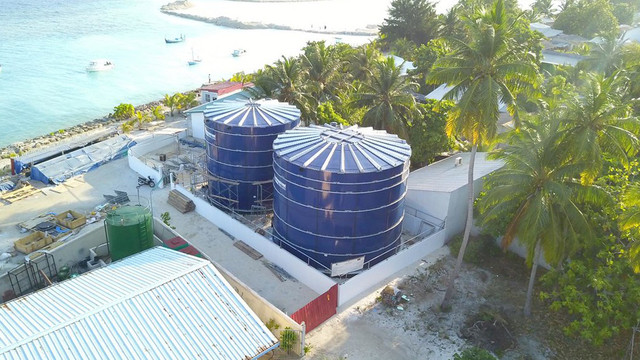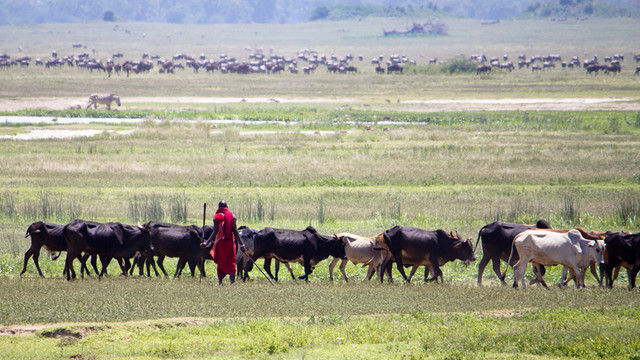Climate adaptation: its time is now
As adaptation shares more of the limelight, champions of community-based adaption have messages on three key areas that international policymakers must hear.


A woman in Malawi carrying a solar panel. Adaptation technologies must recognise the different priorities of men and women (Photo: JonStrand, CC BY-SA 4.0)
Adaptation is finally on the map. The climate change narrative has long been heavily skewed towards mitigation – on how to curb further climate risk and avoid pushing our planet towards climate crisis. But recent years – and months – have seen adaptation climb the political agenda, no longer the ‘poor cousin’ of mitigation.
The forming of the high-profile Global Commission on Adaptation led by former UN secretary-general Ban Ki Moon, World Bank CEO Kristalina Georgieva and Bill Gates has upped the ante with urgent calls for bolder solutions for managing climate risks. The UN secretary-general’s climate summit will take place in September, bringing together world leaders from government, business, finance and civil society to discuss transformative climate initiatives. The Egypt and UK-led resilience and adaptation track will focus on integrating climate risk into government and private sector thinking preparing for climate disasters effectively, and considering how vulnerable groups can recover from disasters faster.
But to be responsive to the priorities of the most vulnerable, these high-level international dialogues must be grounded in the real world.
The community of practice on community-based adaptation (CBA), grown collectively by IIED and partners, has connected local-level adaptation solutions with international dialogues on climate change for almost 15 years. This community has been working to get local adaptation priorities to the heart of discussions on climate change – long before the recent international calls for urgent action.
The CBA top three
Over the years, the CBA community has honed in on three areas:
- Getting finance to countries so they can implement their adaptation projects and programmes
- Transferring technology that will help climate vulnerable communities adapt, and
- Improving adaptation policies so they recognise the challenges faced by vulnerable people most affected by climate change.
These three pillars are politically important – internationally recognised as crucial for delivering the Paris climate agreement. But they also form a platform for local people to demand what they need to solve their own climate problems.
Last month, the CBA community gathered in Addis Ababa to share their experiences of adaptation and discuss how to make change more effective.
Delegates raised concerns that amid the new enthusiasm for adaptation, mistakes of the past could persist whereby priorities of the most vulnerable will continue to be overlooked. The community of practice that gathered for CBA13 recognised this challenge and together developed three sets of compelling messages that include tangible, practical solutions for creating locally-driven change.
Financing that is fit for purpose
The system for delivering climate finance where it is needed does not work. Not only is there not enough funding, but the systems for transmitting that funding are inadequate.
Most large-scale funds such as the Green Climate Fund are inaccessible to countries that need them most, while bilateral funding is often too short term or too small scale to create lasting impact. Only 18% of adaptation finance reaches the Least Developed Countries (LDCs), and only 10% of adaptation finance reaches the local level where it can address, with community input, the local drivers of poverty, natural degradation and climate vulnerability.
Devolved climate finance as practiced by the National Drought Management Authority through the Adaptation Consortium, and climate responsive social protection programmes such as the Hunger Safety Net Programme (both Kenya-based) are working examples of what can be achieved with sustained, patient funding.
Programmes trialling these approaches have succeeded by building on existing systems (rather than creating new ones), and building the capacity of different actors to take the lead.
These kinds of systems can create the pipelines to enable at least 70% of climate finance to reach the local level, a demand put forward by the LDCs to the international community.
Searching for the unicorn
The differing views on the private sector from CBA participants demonstrate the need for clearer thinking and communication on how private sector funding can be mobilised for widespread adaptation.
Some see the private sector as “the unicorn” of adaptation – often talked about, but rarely seen. But others see real potential for private sector investment in the many smallholder farmers on which developing economies depend.
It is critical for projects seeking to leverage the private sector to include such institutions from the very beginning, to ensure their market knowledge and expertise can inform and support innovation. Good examples of success do exist and from which we can learn, such as the Solar Home Systems Initiative by IDCOL, and microinsurance schemes such as AfatVimo (PDF) in India.
Inclusive policies
Policies can supercharge adaptation interventions, creating the conditions for programmes to work. But to do so they must include a wide range of voices. Priorities of women and young people continue to go unheard in policy discussions. Yet governments often do not have capacity, sufficient resource or indeed the motivation to carry out inclusive discussions on a large scale.
Failed development interventions tell us that a business-as-usual approach cannot continue – we need new systems and mechanisms to bring all community members into discussions that inform policy design.
This is particularly crucial for National Adaptation Plans, with the potential to guide countries toward climate-resilient futures. But they are often driven and funded by multilateral agencies. Instead, they need to be led by government institutions that have the convening power and resources to bring different actors together and to break away from the siloed, sectoral approaches of the past.
One example is the Bangladesh Academy for Climate Services, which brings together scientists, policymakers and communities. Another is an online resilience platform, TCHAD-AGORA, that enables users to share their experiences and continue informal discussion directly with policymakers.
Technology: integrating gender and traditions from the past
The technology to adapt to climate change is, in many cases, already available. Getting it to the people that need it most, with the knowledge of how to use it at scale, is the challenge.
We must integrate new technologies with traditional methods from the past, many of which have adapted to their context and are fundamental to sustaining local ecosystems.
Respect for traditional technologies and methods encourage locally led, bottom-up networks or 'ecosystems' of actors for innovation that bring multiple types of technical knowledge together rather than the 'solutions looking for a problem' approach often seen in practice today.
Gender analysis must become a fundamental tool of the technology trade. The design of new technologies must recognise the different priorities of men and women, how they spend their time, socialise and generate income. How gender-sensitive a technology is will determine how well it is taken up by women and men. Practical Action’s renewable energy for smallholders project in Zimbabwe has demonstrated the effectiveness of gender-sensitive approaches.
The CBA community of practice: an invaluable resource
These messages from practitioners on finance, technology and policy add more nuance and greater legitimacy to the messages that the CBA community of practice have long been calling for – that communities must be at the centre of efforts to shape their own resilient futures. Those most at risk must be given higher, broader platforms through which to advise and advocate.
As the Global Commission on Adaptation continues its work, and the UN climate summit gets set to push adaptation further into the limelight, there is opportunity for a dramatic shift in the way adaptation and development is done.
These international processes must take on board the knowledge and experiences of the CBA community. And there is an open invitation to mine this invaluable resource as we seek to build a climate-resilient future.


